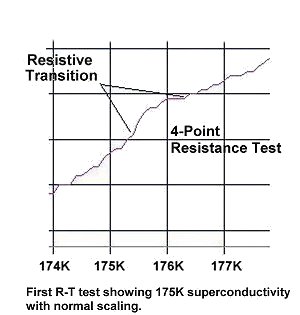
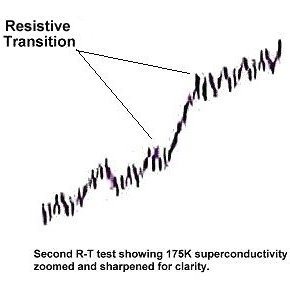
Predicted Superconductivity Near 175K Found
"This would mean...that you've beaten up the 164 K record at HIGH pressure."
- Dr. hab Wojciech Grochala, Ph.D., D.Sc., Group Leader
Laboratory of Technology of Novel Functional Materials, University of Warsaw
3 October 2007
Updated 18 November 2007
Superconductors.ORG
Superconductors.ORG herein reports
signs of superconductivity near 175 Kelvin at ambient pressure. This would be a new
world record for a superconductor whose formula and structure are known. The proposed
chemical formula is
Sn1.4In0.6Ba4Tm5Cu7O20+
with 1245/1212 structure.
Such a high Tc material was thought possible only after the discovery in 2005 of a superconductor
that took advantage of planar weight disparity (PWD) to achieve its then-record Tc of 150K.
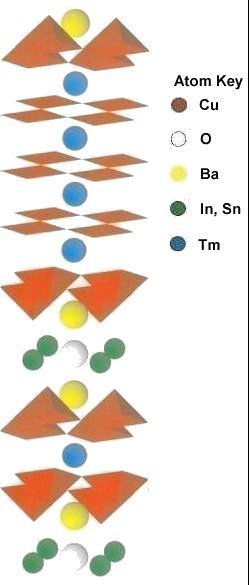
|
The
150K material was based on a 1234/1212 intergrowth structure, which was counter-intuitive to
conventional thinking about Tc-enhancement.
Historically, increasing the number of CuO2 planes in the (Hg,Tl,Pb,Bi)-cuprates
depresses Tc when the Ca-CuO2 layers exceed two. In PWD superconductors
this limitation does not apply. As such, the next logical step was to attempt a 1245/1212 intergrowth (shown at left) -
which contains one more Tm-CuO2 layer than the 1234/1212 structure. Tc-vs-PWR extrapolation (see log
graph below) suggested such a material should produce a Tc between 160K and 190K. However, finding the
1245/1212 superconductivity signature within a multi-phasic bulk proved difficult, due to
the small volume fraction that results.
Very high planar weight ratios are
not attainable by stoichiometric synthesis. They occur only as byproducts.
So, a means needed to be derived wherein a minority phase of 1245/1212
material would occur in amounts large enough to measure within the
bulk of a parent compound.
Success was finally realized by increasing the
amount of Tm and Cu by 5% in a 1223/1212 host. And, by increasing the ratio of Sn to In
from 5:5 to 7:3.
Four separate tests of the resulting material showed sharp resistive transitions near
175K, 174K 176K and 177K for the minority phase. Three of those plots are shown below
and the fourth is at top left.

A patent has been applied for the general formula
(Sn,In)2Ba4Tm5Cu7O20+
|
Below is the plot of a composite magnetization test. The magnetometer
uses twin Honeywell SS94A1F Hall-effect sensors operating at the limit of their sensitivity.
3 separate tests were performed and digitally summed together. This was done to improve the signal-to-noise
ratio. Since the noise floor from each plot is out of phase with the other plots, they add together as a
root-mean-square function. The Meissner transitions, however, are in-phase and sum arithmetically.
In fact, using this technique, it should be possible to resolve
the superconductivity signature of a 1256/1212 phase, if one exists.
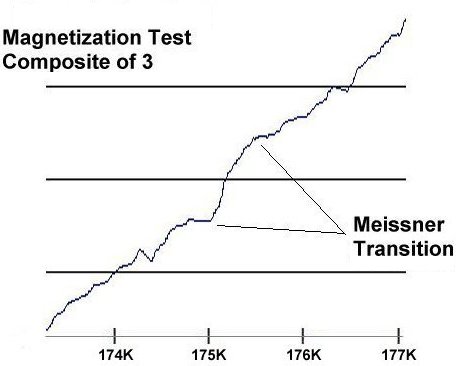
The inclination of the Tc-vs-PWR plot (below)
shows a lower angle approaching 1245/1212. This can be attributed to the 1245/1212 unit
cell having 18 metal layers. Empirically, 16 layers has been found to be optimal.
Thus, the 1245/1212 unit cell is slightly larger than ideal.
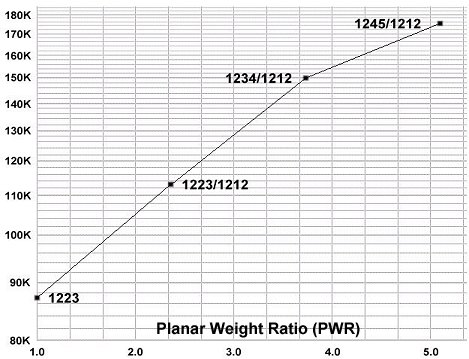
Below are the other 3 structure types
from the Tc-vs-PWR plot. These members of the Sn-In-Ba-Tm-Cu family suggested the
existence of an even higher Tc material between 160K and 190K.
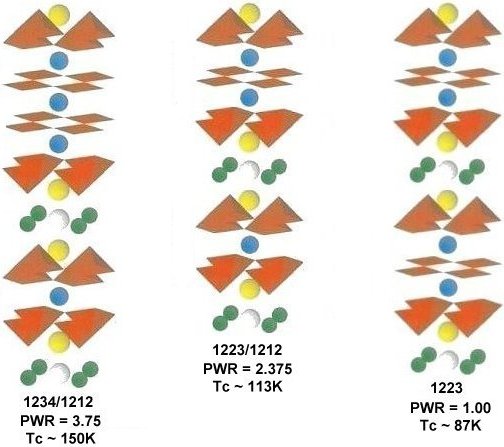

Synthesis of the material was by the solid state reaction method.
Stoichiometric amounts of the below precursors were mixed, pelletized at 70,000 psi and sintered for 36 hours at 830C.
The pellet was then annealed for 10 hours at 500C in flowing O2.
SnO 99.9% (Alfa Aesar)
In2O3 99.9% (Alfa Aesar)
Tm2O3 99.99% (Stanford Materials) [stoichiometric +5%]
BaCuOx 99.9% (Alfa Aesar)
CuO 99.995% (Alfa Aesar) [stoichiometric +5%]
RESEARCH NOTE: Tm-copper-oxides have been found to be strongly hygroscopic.
All tests should be performed immediately after annealing.
- E. Joe Eck
© 2007 Superconductors.ORG
Patent Pending. All rights reserved.
 BACK to "News" page at Superconductors.ORG
BACK to "News" page at Superconductors.ORG









 BACK to "News" page at Superconductors.ORG
BACK to "News" page at Superconductors.ORG